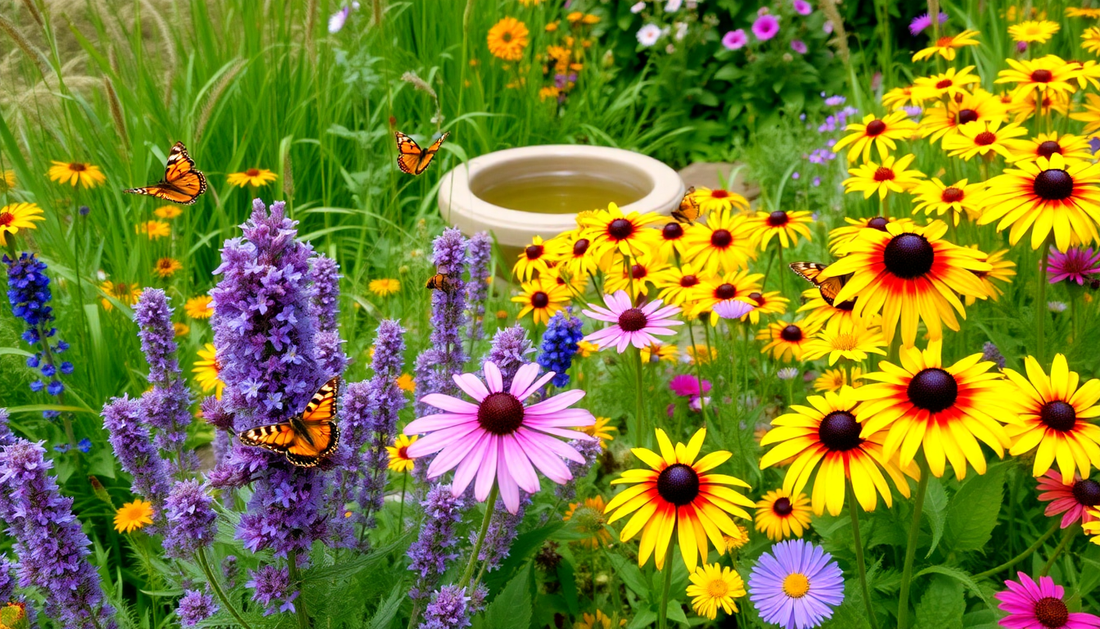
The Best Flowering Plants for Wildlife Gardens
Share
In the ever-evolving world of gardening, there is a growing emphasis on creating spaces that not only delight the human eye but also support the delicate balance of our local ecosystems. As we become more conscious of the importance of biodiversity, the concept of the "wildlife garden" has gained significant traction. These gardens are designed to provide a haven for a diverse array of flora and fauna, offering a sanctuary for pollinators, birds, and other beneficial creatures.
At the heart of this movement lies the careful selection of flowering plants that not only add visual appeal but also serve as a vital food source and habitat for our winged and four-legged friends. In this comprehensive guide, we will explore the best flowering plants for wildlife gardens, highlighting their unique attributes and the role they play in sustaining a thriving ecosystem.
The Importance of Flowering Plants in Wildlife Gardens
Flowering plants are the cornerstone of any wildlife garden, serving as a crucial food source and shelter for a wide range of creatures. From nectar-feeding butterflies and hummingbirds to pollen-collecting bees and other pollinators, these vibrant blooms are essential for maintaining a healthy, balanced ecosystem.
Beyond their role in supporting local wildlife, flowering plants also contribute to the overall aesthetic appeal of the garden. By carefully selecting a diverse array of species that bloom at different times throughout the season, gardeners can create a visually stunning and ever-changing landscape that delights the senses.
The Best Flowering Plants for Wildlife Gardens
When it comes to creating a wildlife-friendly garden, not all flowering plants are created equal. Some species are more attractive to pollinators and other beneficial creatures, while others may provide essential food sources or shelter. Here are some of the best flowering plants to consider for your wildlife garden:
Coneflowers (Echinacea)
Coneflowers, with their vibrant, daisy-like blooms, are a beloved staple in many wildlife gardens. These hardy perennials are a magnet for butterflies, bees, and even hummingbirds, who are drawn to their nectar-rich flowers. Coneflowers also provide a valuable food source for birds, who feast on the seeds that develop after the blooms have faded.
Sunflowers (Helianthus)
Sunflowers are not only a cheerful addition to any garden, but they also play a crucial role in supporting local wildlife. These tall, striking plants offer a rich source of nectar and pollen for bees, butterflies, and other pollinators. Additionally, their large, seed-filled heads provide a valuable food source for birds, making them a must-have for any wildlife-friendly garden.
Milkweed (Asclepias)
Milkweed is a true champion of the wildlife garden, as it is the sole host plant for the iconic monarch butterfly. These vibrant, nectar-rich flowers are a magnet for a wide range of pollinators, including bees, hummingbirds, and, of course, the beloved monarch. By incorporating milkweed into your garden, you'll be providing a vital lifeline for these threatened butterflies.
Bee Balm (Monarda)
Bee balm, also known as wild bergamot, is a fragrant and eye-catching addition to any wildlife garden. Its showy, tubular flowers are irresistible to hummingbirds, bees, and butterflies, who are drawn to its abundant nectar. Beyond its pollinator-attracting properties, bee balm also has a long history of use in traditional medicine, making it a versatile and valuable plant for the garden.
Purple Coneflower (Echinacea purpurea)
The purple coneflower is a true standout in the wildlife garden, with its striking, daisy-like blooms and robust, drought-tolerant nature. These plants are a magnet for a wide range of pollinators, including bees, butterflies, and even moths. Additionally, the seeds that develop after the flowers fade provide a valuable food source for birds, making the purple coneflower a true all-star in the wildlife garden.
Creating a Diverse and Thriving Wildlife Garden
While the flowering plants mentioned above are excellent choices for any wildlife garden, it's important to remember that diversity is key. By incorporating a wide range of species that bloom at different times throughout the season, you can create a lush, ever-changing landscape that supports a diverse array of local wildlife.
When planning your wildlife garden, consider the unique needs and preferences of the creatures you hope to attract. Some plants may be more attractive to specific pollinators or provide better shelter for certain species. By researching the specific requirements of the wildlife in your area, you can tailor your garden to their needs and create a true oasis for local flora and fauna.
In addition to carefully selecting your flowering plants, it's also important to consider the overall design and layout of your wildlife garden. Incorporating elements like water sources, dense plantings, and sheltered areas can provide the necessary resources and protection for your winged and four-legged visitors.
As you embark on your journey to create a thriving wildlife garden, remember that it's a continuous process of learning, experimentation, and observation. By staying attuned to the needs of your local ecosystem and making adjustments as necessary, you can cultivate a garden that not only delights the human eye but also serves as a vital sanctuary for the diverse and fascinating creatures that call it home.
Conclusion
The creation of a wildlife garden is a rewarding and impactful endeavor that benefits both the natural world and the human spirit. By carefully selecting a diverse array of flowering plants that cater to the needs of local pollinators, birds, and other creatures, gardeners can play a vital role in sustaining the delicate balance of our ecosystems.
Whether you're starting from scratch or looking to enhance an existing garden, the principles outlined in this guide will help you create a vibrant, wildlife-friendly oasis that will bring joy and wonder to you and your local community of flora and fauna. So, let's get planting and watch as our gardens come alive with the fluttering, buzzing, and chirping of the creatures we've invited to call it home.
